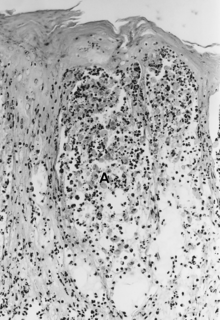 W
WAcantholysis is the loss of intercellular connections, such as desmosomes, resulting in loss of cohesion between keratinocytes, seen in diseases such as pemphigus vulgaris. It is absent in bullous pemphigoid, making it useful for differential diagnosis.
 W
WAcantholytic dyskeratotic epidermal nevus is a cutaneous condition identical to the generalized form of Darier's disease. "Acantholytic dyskeratotic epidermal nevus" is probably the same disorder.
 W
WAcrospiroma is a cutaneous condition, primarily occurring in adult women, that is a form of benign adnexal neoplasm closely related to poroma.
 W
WAminolevulinic acid dehydratase deficiency porphyria is a rare autosomal recessive metabolic disorder that results from inappropriately low levels of the enzyme delta-aminolevulinic acid dehydratase (ALAD), which is required for normal heme synthesis. This deficiency results in the accumulation of a toxic metabolic precursor in the heme synthesis pathway called aminolevulinic acid (ALA). Heme is a component of hemoglobin which carries oxygen in red blood cells.
 W
WBenign neonatal hemangiomatosis is a cutaneous condition in infants, characterized by multiple cutaneous lesions without evident visceral hemangiomas.
 W
WAbraham Buschke was a Jewish German dermatologist who was a native of Nakel in the Province of Posen.
 W
WDarier's sign is a change observed after stroking lesions on the skin of a person with systemic mastocytosis or urticaria pigmentosa.
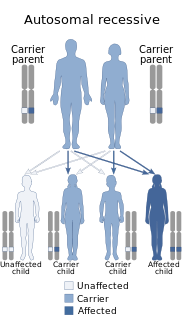 W
WDeSanctis–Cacchione syndrome or Xeroderma pigmentosum is a Genetic disorder characterized by the skin and eye symptoms of xeroderma pigmentosum (XP) occurring in association with microcephaly, progressive mental retardation, retarded growth and sexual development, deafness, choreoathetosis, ataxia and quadriparesis.
 W
WDolichol kinase deficiency is a cutaneous condition caused by a mutation in the dolichol kinase gene.
 W
WEpidermolytic acanthomas are a cutaneous condition characterized by discrete keratotic papules in adults.
 W
WExtraskeletal chondroma is a cutaneous condition, a rare benign tumor of mature cartilage.
 W
WFibroma of tendon sheath is a benign tumor that presents as a small subcutaneous nodule that slowly increases in size. The tumors often have a multinodular growth pattern, with individual nodules being composed of bland, slender, spindle-shaped cells (myofibroblasts) in a dense, fibrous matrix.” A common microscopic finding is the presence of elongated, slit-like blood vessels. The lesions nearly always arise in the distal portions of the extremities. They often occur on the fingers, hands, toes, or feet. Although they are benign, they may recur in up to 40% of cases.
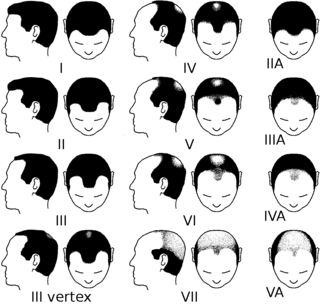 W
WThe Hamilton–Norwood scale is used to classify the stages of male pattern baldness. The stages are described with a number from 1 to 7.
 W
WHereditary mucoepithelial dysplasia (HMD), or simply mucoepithelial dysplasia, is a rare autosomal dominant multiepithelial disorder causing systemic maldevelopment of the epithelia and mucous membranes that line the surface of tissues and structures throughout the body, particularly affecting systems affiliated with mucosa, which includes the respiratory, digestive, urinary, reproductive and immune systems. The disorder is attributed to improper formation of desmosomes and gap junctions, which prevents proper cornification of the epithelial layer of the skin.
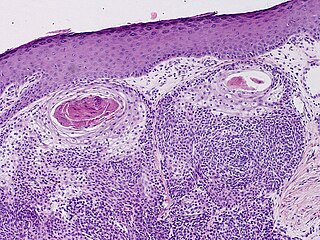 W
WHidradenocarcinoma is a malignant adnexal tumor of the sweat gland. It is the malignant variant of the benign hidradenoma. It may develop de novo or in association with an existent hidradenoma.
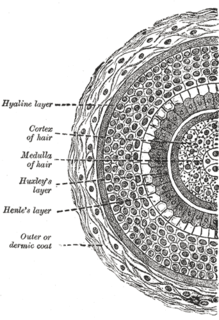 W
WHuxley's layer is the second layer of the inner root sheath of the hair consists of one or two layers of horny, flattened, nucleated cells. It lies between Henle's layer and the cuticle. The layer is named after English biologist Thomas Henry Huxley.
 W
WKraurosis vulvae is a cutaneous condition characterized by atrophy and shrinkage of the skin of the vagina and vulva often accompanied by a chronic inflammatory reaction in the deeper tissues.
 W
WLarge-cell acanthomas are a cutaneous condition characterized by small, skin-colored, hyper- or hypopigmented papules or plaques.
 W
WLaugier–Hunziker syndrome is a cutaneous condition characterized by hyperpigmentation of the oral mucosa, longitudinal melanonychia, and genital melanosis.
 W
WLetterer–Siwe disease is one of the four recognized clinical syndromes of Langerhans cell histiocytosis (LCH). It causes approximately 10% of LCH disease and is the most severe form. Prevalence is estimated at 1:500,000 and the disease almost exclusively occurs in children less than three years old. The name is derived from the names of Erich Letterer and Sture Siwe.
 W
WLIG4 syndrome is an extremely rare condition caused by mutations in the DNA Ligase IV (LIG4) gene. Some mutations in this gene are associated with a resistance against multiple myeloma and Severe Combined Immunodeficiency. Severity of symptoms depends on the degree of reduced enzymatic activity of Ligase IV or gene expression. Ligase IV is a critical component of the non-homologous end joining (NHEJ) mechanism that repairs DNA double-strand breaks. It is employed in repairing DNA double-strand breaks caused by reactive oxygen species produced by normal metabolism, or by DNA damaging agents such as ionizing radiation. NHEJ is also used to repair the DNA double-strand break intermediates that occur in the production of T and B lymphocyte receptors.
 W
WSvend Lomholt was a Danish veterinarian and dermatologist.
 W
WThe Ludwig scale is a method of classifying female pattern baldness, and ranges from stages I to III.
 W
WLupus band test is done upon skin biopsy, with direct immunofluorescence staining, in which, if positive, IgG and complement depositions are found at the dermoepidermal junction. This test can be helpful in distinguishing systemic lupus erythematosus (SLE) from cutaneous lupus, because in SLE the lupus band test will be positive in both involved and uninvolved skin, whereas with cutaneous lupus only the involved skin will be positive.
 W
WThe medulla is the innermost layer of the hair shaft. This nearly invisible layer is the most soft and fragile, and serves as the pith or marrow of the hair. Scientists are still uncertain about the exact role of the medulla, but they speculate that it is primarily an extension that is more prominent in depigmented hair .
 W
WMelanoma with features of a Spitz nevus is a cutaneous condition characterized histologically with tissue similar to a spitz nevus and with overall symmetry and a dermal nodule of epithelioid melanocytes that do not mature with progressively deeper dermal extension.
 W
WA Myxoid cyst is a cutaneous condition often characterized by nail plate depression and grooves.
 W
WNager acrofacial dysostosis, also known as Nager syndrome, is a genetic disorder which displays several or all of the following characteristics: underdevelopment of the cheek and jaw area, down-sloping of the opening of the eyes, lack or absence of the lower eyelashes, kidney or stomach reflux, hammer toes, shortened soft palate, lack of development of the internal and external ear, possible cleft palate, underdevelopment or absence of the thumb, hearing loss and shortened forearms, as well as poor movement in the elbow, and may be characterized by accessory tragi. Occasionally, affected individuals develop vertebral anomalies such as scoliosis.
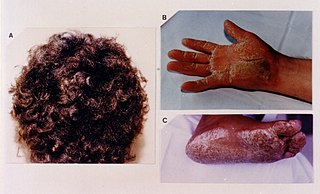 W
WNaxos disease is a cutaneous condition characterized by a palmoplantar keratoderma. The prevalence of the syndrome is up to 1 in every 1000 people in the Greek islands.
 W
WNecrolytic acral erythema is a cutaneous condition that is a manifestation of hepatitis C viral infection or zinc deficiency.
 W
WNevoid melanoma is a cutaneous condition that may resemble a Spitz nevus or an acquired or congenital melanocytic nevus.
 W
WA non-blanching rash (NBR) is a skin rash that does not fade when pressed with, and viewed through, a glass.
 W
WPalisaded encapsulated neuroma (PEN) is a rare, benign cutaneous condition characterized by small, firm, non-pigmented nodules or papules. They typically occur as a solitary (single) lesion near the mucocutaneous junction of the skin of the face, although they can occur elsewhere on the body.
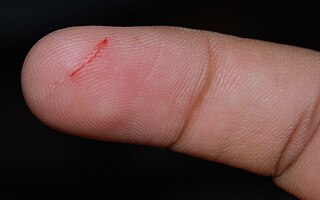 W
WA paper cut occurs when a piece of paper or other thin, sharp material slices a person's skin. Paper cuts, though named from paper, can also be caused by other thin, stiff, and abrasive materials.
 W
WA pigmented spindle cell nevus is a skin condition characterized by a dark brown to black macule or papule, usually less than 6 mm.
 W
WPleomorphic fibromas of the skin usually present in adults, with a slight preponderance in women.
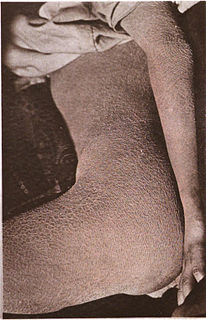 W
WRuzicka Goerz Anton syndrome is a rare genetic disease described by Ruzicka et al. in 1981. It is characterized by icthyosis, deafness, intellectual disability, and skeletal anomalies.
 W
WA sebaceous filament is a tiny collection of sebum and dead skin cells around a hair follicle, which usually takes the form of a small, yellow to off-white hair-like strand when expressed from the skin..
 W
WSetleis syndrome is a very rare genetic condition characterized by facial skin abnormalities and double upper eyelashes and absent lower eyelashes. It belongs to a group of diseases known as ectodermal dysplasias. Ectodermal dysplasias typically affect the hair, teeth, nails, and/or skin. Setleis syndrome is characterized by distinctive abnormalities of the facial area that may be apparent at birth (congenital). Most affected infants have multiple, scar-like, circular depressions on both temples (bitemporal). These marks closely resemble those made when forceps are used to assist delivery. The range and severity of symptoms may vary from case to case.
 W
WShiitake mushroom dermatitis is an intensely pruritic dermatitis characterized by disseminated 1mm erythematous micropapules seen in a linear grouped arrangement secondary to Koebnerization due to patient scratching. It is caused by the ingestion of shiitake mushrooms and was first described in 1977 by Nakamura. Although it is rarely seen outside of China and Japan due to a lower incidence of shiitake consumption outside these regions, there is a well-established association between flagellate dermatitis and shiitake mushroom ingestion. Bleomycin ingestion may also cause similar findings. On physical exam, one key difference between the two is that post-inflammatory hyperpigmentation changes are usually seen with bleomycin-induced flagellate dermatitis and are not typically present with shiitake mushroom induced flagellate dermatitis. The median time of onset from ingestion of shiitake mushrooms is typically 24 hours, ranging from 12 hours to 5 days. Most patients completely recover by 3 weeks, with or without treatment. Although the pathogenesis of shiitake induced flagellate dermatitis is not clear, the theory most argued for is a toxic reaction to lentinan, a polysaccharide isolated from shiitake mushrooms. However, Type I and Type IV allergic hypersensitivities have also been supported by the 24-hour median time of onset, clearance in 3–21 days, severe pruritus, benefit of steroids and antihistamines, and lack of grouped outbreaks in people exposed to shared meals containing shiitake mushrooms. Most cases reported shortly after its discovery were due to consumption of raw shiitake mushrooms, but several cases have since been reported after consumption of fully cooked mushrooms.
 W
WA skin fissure is a cutaneous condition in which there is a linear-like cleavage of skin, sometimes defined as extending into the dermis. It is smaller than a skin laceration.
 W
WSmall-cell melanoma, also known as melanoma with small nevus-like cells, is a cutaneous condition, a tumor that contains variably-sized, large nests of small melanocytes with hyperchromatic nuclei and prominent nucleoli.
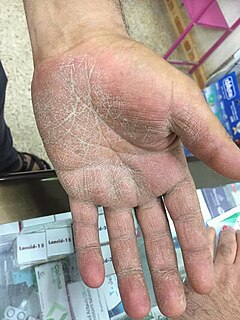 W
WTinea manuum is a fungal infection of the hand. It is typically more aggressive than tinea pedis but similar in look. Itching, burning, cracking, and scaling are observable and may be transmitted sexually or otherwise, whether or not symptoms are present. Alternatively, it may be caused by an allergic reaction, known as a "dermatophytid reaction". "For example, a fungal infection on the foot may cause an itchy, bumpy rash to appear on the fingers. These eruptions are allergic reactions to the fungus. They do not result from touching the infected area. The eruptions may appear on many different areas of the body at once."
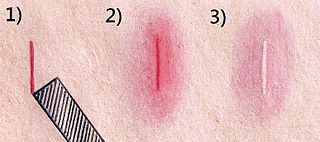 W
WThe triple response of Lewis is a cutaneous response that occurs from firm stroking of the skin, which produces an initial red line, followed by a flare around that line, and then finally a wheal.
 W
WTuberculous gumma is a skin condition characterized histologically by massive necrosis. Restated, this is a skin condition that results from hematogenous dissemination of mycobacteria from a primary focus, resulting in firm, nontender erythematous nodules that soften, ulcerate, and form sinuses.
 W
WUV-sensitive syndrome is a cutaneous condition inherited in an autosomal recessive fashion, characterized by photosensitivity and solar lentigines. Recent research identified that mutations of the KIAA1530 (UVSSA) gene as cause for the development of UV-sensitive syndrome. Furthermore, this protein was identified as a new player in the Transcription-coupled repair (TC-NER).
 W
WVacuolization is the formation of vacuoles or vacuole-like structures, within or adjacent to cells. Perinuclear vacuolization of epidermal keratinocytes is most likely inconsequential when not observed in combination with other pathologic findings. In dermatopathology "vacuolization" often refers specifically to vacuoles in the basal cell-basement membrane zone area, where it is an unspecific sign of disease. It may be a sign of for example vacuolar interface dermatitis, which in turn has many causes.
 W
WVenetian ceruse, also known as blanc de ceruse de Venise and Spirits of Saturn, was a 16th-century cosmetic used as a skin whitener. It was in great demand and considered the best available at that time. It is similar to the regular ceruse, although it was marketed as better, more exclusive and expensive than the regular ceruse variant. The regular ceruse white pigment is a basic lead carbonate of chemical formula 2 PbCO3·Pb(OH)2 while the mineral cerussite is a simple carbonate of lead.